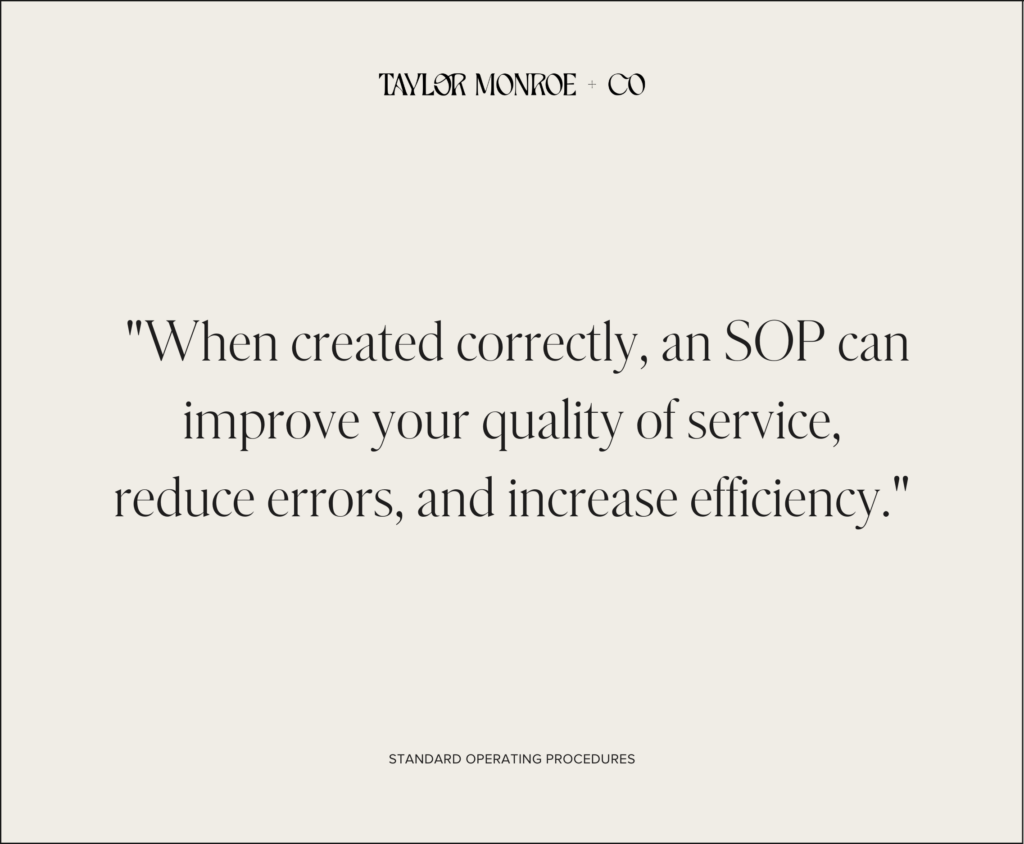go back
Here’s the secret we’ve been holding back on: your business can’t run smoothly without Standard Operating Procedures (SOPs) in place. While we’ll admit, it might not be the juiciest secret around, that doesn’t mean we can cast SOPs to the wayside. In fact, SOPs are an essential part of any business (especially if your business plans on scaling).
Your SOPs are like the guidebook to your business. They’re key to ensuring everyone on your team is working on the same page and achieving the same objectives (kind of a no-brainer, right?). While your SOPs are an essential part of business, they’re also a part that many business owners leave out.
If you’re ready to increase your business’ efficiency, scale effectively, and guide your team members, then it’s time to chat SOPs. Read on for all the details on what an SOP is, what should be included in your SOPs and how to create your SOPs in 6 easy steps.
Pin this blog for later! ↓

Please note that some links in this blog post are affiliate links, which means we may receive a commission if you purchase using our link. Honestly, we just love sharing what we’ve been loving lately, and if that means you can get in on the sweet deals as well, then great!
What is an SOP?
Let’s get some of the complicated lingo out of the way. First of all, what even is an SOP?
An SOP is essentially how you track and manage the many tiny processes that your business completes on a day-to-day basis. The goal? To create a record of how to do each task properly. This is especially important as your business grows and you’re looking to delegate tasks that you can’t do yourself. An SOP makes it much easier to outsource those tasks you no longer have the bandwidth for because you already have the standard guidelines in place.
When created correctly, an SOP can help us as business owners do many things:
First, they help us deliver the same quality of service time and time again, while also reducing errors. Not only is this important if you’re working as a solopreneur and want to be consistent with your work output, but it’s also great to have in place if you operate an agency or work with subcontractors.
Second, an SOP ensures a smooth transition when onboarding and training new hires. As we touched on above, if you’re ready to duplicate your skills, ensure you have a great SOP in place! This will make the training process much easier and faster for both of you. And, with all this extra time on your hands, you’ll be able to dedicate more attention to your clients!
Third, your SOP will be able to help with audits on ways you can automate. And, above all else, it can keep track of the processes in your business so that you can increase efficiency. This especially goes for those pesky tasks that always pop up but you can never remember how you solved them last time around.

What Should an SOP Include?
Now, let’s chat about what an SOP should include. We guarantee that you’ll need to create a variety of SOPs for different business tasks as well as for different team members. However, there are some commonalities that go across each SOP. Here’s what every SOP should include:
- The name of the SOP
- Who created the SOP and who on the team (or your client) will have tasks assigned within it
- When the SOP was created and last updated (really important as your business grows)
- A brief description and the SOP’s purpose
- Assets needed (tools, logins, programs) and who needs access
- The actionable steps to complete the task (aka the how-tos)
Pro Tip: Lots of SOPs on your hands? Make sure to organize them into a folder or playbook to easily reference! This can be a Google Drive folder, ClickUp doc, or Airtable – whatever works best for the systems in your business (we like to keep ours in ClickUp as then we can easily reference and link them within corresponding tasks!).
6 Easy Steps to Create Your SOPs
Now that your brain is filled with lots of great SOP knowledge, here are 6 easy steps to follow to create your own SOPs:
1. Make a brain dump of the different tasks that happen in your business on the regular.
Prioritize your recurring tasks. Start by thinking about all your daily and weekly tasks, then move onto monthly then quarterly then annually. An easy way to get this list is to write down the list of tasks as you go about your day/week – for more tips on organizing your recurring tasks, click here.
2. Write out the process of completing each task. (This is the HOW of doing the task.)
We find it’s easiest to do this as you’re actually doing the task. This way, you can write down everything you’re doing as you do it! While completing the task will take longer, you’ll finish with a great first draft of your SOP. (Plus, as an added bonus, you might even pick up on ways to optimize your task!)
Remember, you need to make the process very detailed – no step is too small! Make sure the steps are clear for someone who’s never used the system/program before. It’s not insulting to pretend you’re speaking to a toddler (believe us, they’ll appreciate it!).
3. Add images or videos as necessary.
We love Loom here at team TM+Co! Videos and images are great to help with understanding each step (we find it super helpful to be able to actually see what you’re supposed to do.) Everyone learns differently, so visuals are a must to help different styles of learners.
4. Have team members write the SOPs for their recurring tasks.
If you already have a team or a VA, it’s helpful to have them create the SOPs for the tasks they complete. They know the process best, so it should be them who takes the lead! After they document their steps, that’s when you can see if there’s potential to optimize the task process further.
5. Have your team or client read through the SOP to make sure nothing got missed.
Once the SOP is created, have the person who’s assigned that task go back through the SOP step by step. With fresh eyes, they may be able to spot any missing or incomplete steps. Be sure to ask: are there any problems that can be averted or modified?
6. Final quality check!
You’ve made it to the final step! Now it’s time to make triple sure everything looks good. Once finished, add your SOP into your SOP organizational structure for easy reference. Don’t forget to make sure anyone who needs it has access!
Above all else, remember this: SOP creation and audits are ongoing tasks in your business. As much as you might dread the process, it’s always going to be a part of growing and scaling your business! So, make sure to regularly audit your SOPs to check over them for any changes or improvements. This process should be a quarterly task for you and your team.
As your business evolves and changes over time, so too will your SOPs. So, be sure to carve out the necessary time to check that everything is running smoothly and to see if there’s room for improvement and optimization.
Need help creating or updating your current SOPs? The documentation and creation of SOPs can be tedious. We can help give your business more clarity through the implementation of seamless systems that work for you on autopilot (and, believe us, we have fun while doing so 😊). You can learn more about our services here.
up next
